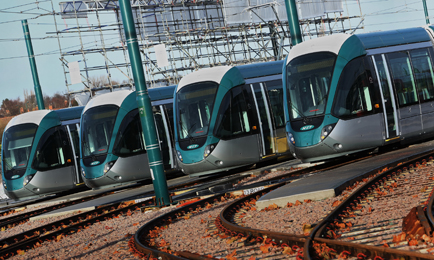Engineers are developing advanced composite materials that could be applied to the tram industry to save costs.
Industry body UK Tram, which is overseeing the research, said new composite equipment design could result in cost savings of up to £100,000 per kilometre of track.
The Low Impact Light Rail initiative – funded by Innovate UK – will to look at adapting composite materials for use in the overhead line equipment used to supply power to trams. Stage one of the composite overhead line structure research project involves the development of a viable gantry design, with an ultimate aim of reducing the whole life cost of these kinds of structure.
The research will be carried out by a consortium UK comprising engineers from Atkins, Brecknell Willis and Cecence.
Paul Hooper from Atkins said: “There is potential to significantly reduce the costs of overhead line systems by utilising advanced composites in the support structures as an alternative to traditional metallic structures. Additionally these materials have the potential to reduce the amount of equipment required and can be readily shaped to blend into the environment and thereby reduce the visual impact.
“For the composite overhead line structure project the partners are proposing supporting the copper ‘contact wire’ from a high tensioned carbon-fibre reinforced plastic (CFRP) catenary cable. The cable itself would also be supported by glass-fibre reinforced plastic (GFRP) poles and support cantilevers.”
Composite materials are up to four times stiffer than metals for the same mass, and are up to ten times stronger. GFRP is electrically insulating and CFRP does not expand or contract as the temperature changes. Due to these properties the proposed new design will mean the spacing between pylons can be increased by approximately 40% which would therefore require fewer poles and less cable tensioning equipment. It would also eliminate the need for electrical isolation and reduce the amount of electrical bonding required.
GFRP is also more resistant to corrosion, meaning that it will be longer lasting, less subject to environmental damage and thereby cheaper to maintain. As a result it is believed that inspection and maintenance will only be required every 15 years, rather than every five. The anticipated life of the pylons will also increase with replacements required approximately every 40 years rather than every 25. Although elements of the proposed design are more expensive than existing options, the estimated cost savings for the project are substantial, ranging from £50k-£100k per kilometre for a typical track where pylons are used. A similar cumulative maintenance saving is also expected after seven years of operation.
Stage one of the composite overhead line structures project is expected to be completed by the end of January 2015 with stage two focussed on a demonstration of the pilot structure later this year.
Atkins’ rail and aerospace teams are conducting the requirements and risk analyses, cost benefit analysis, and design and stress analysis. Cecence are working on the design and cost for the carbon cables and Brecknell Willis will be undertaking an independent review of the work.



